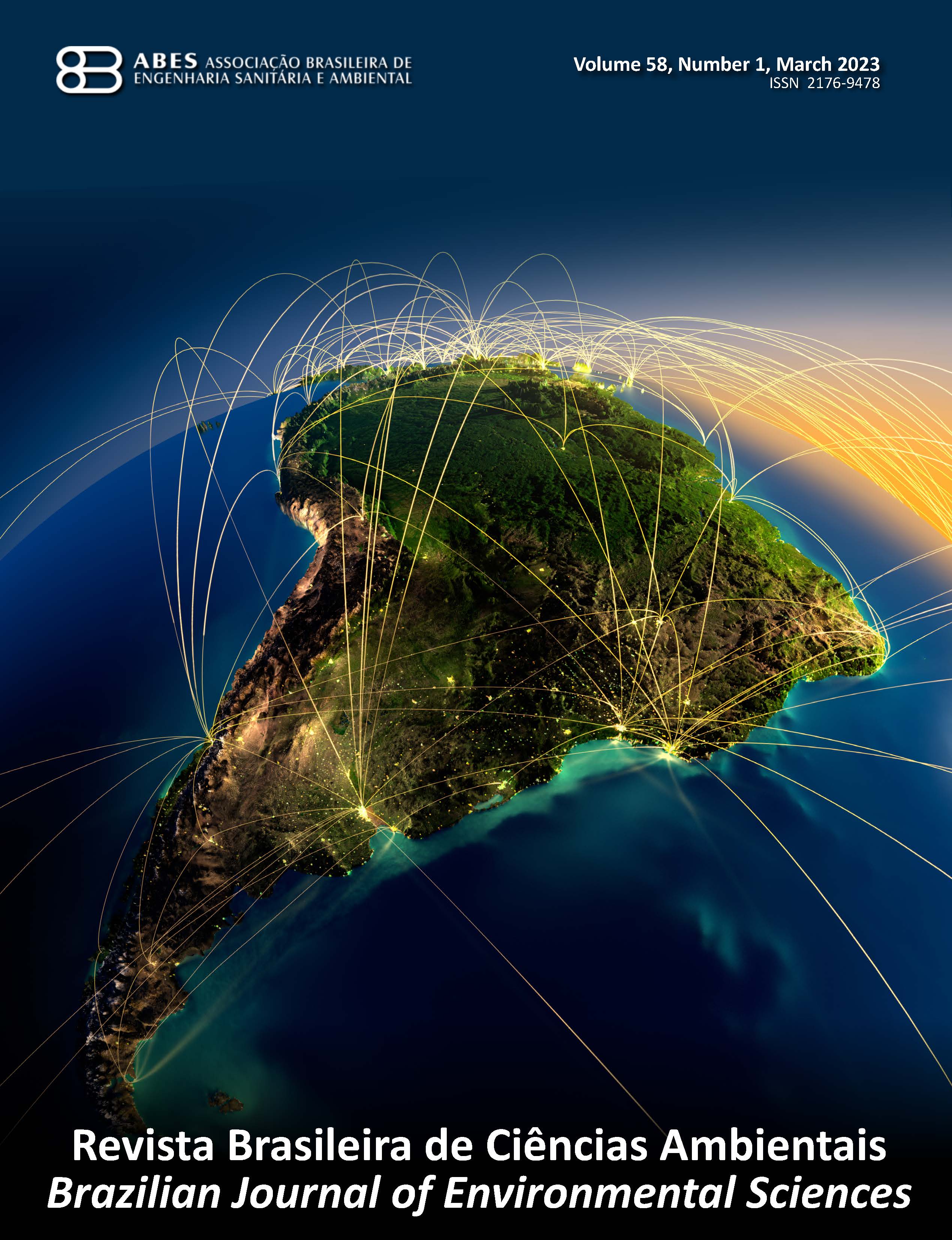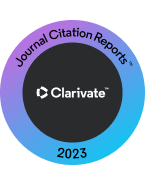Pressure regulation and energy recovery in water distribution networks using pumps as turbines
DOI:
https://doi.org/10.5327/Z2176-94781551Keywords:
WDN sectorization; PAT off-design operation; pressure control; energy recovery; sustainabilityAbstract
Water distribution networks (WDNs) are considered a potential renewable energy source, as they have more than enough pressure energy to deliver water to users. To control excessive pressure, WDNs are commonly divided into district metered areas (DMAs) with pressure-reducing valves (PRVs). The energy wasted by PRVs can be recovered using pumps as turbines (PATs). However, selecting the appropriate pump remains a challenge, as it must account for daily pressure and flow variations from consumers (off-design conditions). In this article, a combination of models was validated and applied to select the suitable pump for operating in an actual WDN. The replacement of two PRVs with PATs in a real network, previously divided into two DMAs and operating at constant speed was investigated. Economic and environmental analyses were also conducted. PAT1 was technically superior to PAT2, as PAT2 exhibited negative outlet pressure, affecting the pressure in DMA2. Optimal efficiencies are achieved at flow rates corresponding to the pump’s best efficiency point or near it, mimicking pressure control as if they were the valves themselves. The most efficient pump recovered 4,331 kWh/year, equivalent to a reduction of 1,732,400 gCO2/year, serving two households categorized as low-income. PATs proved to be a viable alternative, with a payback period of 2.1 years, as it can recover renewable energy. However, for effective pressure control in WDNs, other operational strategies, such as variable speed operation, should be explored.
Downloads
References
Alatorre-Frenk, C., 1994. Cost Minimisation in Micro-Hydro Systems Using Pumps-as-Turbines. Thesis.
Alberizzi, J.C.; Renzi, M.; Nigro, A.; Rossi, M., 2018. Study of a Pump-as-Turbine (PaT) Speed Control for a Water Distribution Network (WDN) in South-Tyrol Subjected to High Variable Water Flow Rates. Energy Procedia, v. 148, 226-233. https://doi.org/10.1016/j.egypro.2018.08.072.
Alves, I.M.; Bezerra, S.T.M.; Silva, G.L.; Duarte, A.D.; Maranduba, H.L., 2022. Analysis of the Water–Energy–Greenhouse Gas Nexus in a Water Supply System in the Northeast of Brazil. Brazilian Journal of Environmental Sciences (RBCIAMB), v. 57, (1), 12-21. https://doi.org/10.5327/z217694781036.
Associação Brasileira de Normas Técnicas (ABNT), 2017. NBR 12218/2017: Projeto de Rede de Distribuição de Água Para Abastecimento Público. Rio de Janeiro, ABNT.
Balacco, G.; Binetti, M.; Caporaletti, V.; Gioia, A.; Leandro, L.; Iacobellis, V.; Sanvito, C.; Piccinni, A. F., 2018. Innovative Mini-Hydro Device for the Recharge of Electric Vehicles in Urban Areas. International Journal of Energy and Environmental Engineering, v. 9, 435-445. https://doi.org/10.1007/s40095-018-0282-8.
Bhattacharya, M.; Paramati, S.R.; Ozturk, I.; Bhattacharya, S., 2016. The Effect of Renewable Energy Consumption on Economic Growth: Evidence from Top 38 Countries. Applied Energy, v. 162, 733-741. https://doi.org/10.1016/j.apenergy.2015.10.104.
Brasil. Governo do Brasil, 2014. Inventário Nacional de Emissões Atmosféricas Por Veículos Rodoviários (Accessed October, 2022). Retrieved from: https://antigo.mma.gov.br/images/arquivo/80060/Inventario_de_Emissoes_por_Veicul os_Rodoviarios_2013.pdf.
Caputo, A.; Sarti, C., 2015. Fattori Di Emissione Atmosferica Di CO2 e Sviluppo Delle Fonti Rinnovabili Nel Settore Elettrico, Rapporto ISPRA 212/2015.
Carravetta, A.; Fecarotta, O.; Giudic, G. del; Ramos H., 2014. Energy Recovery in Water Systems by PATs: A Comparisons among the Different Installation Schemes. Procedia Engineering, v. 70, 275-284. https://doi.org/10.1016/j.proeng.2014.02.031.
Carravetta, A.; Fecarotta, O.; Ramos, H.M., 2018. A New Low-Cost Installation Scheme of PATs for Pico-Hydropower to Recover Energy in Residential Areas. Renewable Energy, v. 125, 1003-1014. https://doi.org/10.1016/j.renene.2018.02.132.
Coelho, B.; Andrade-Campos, A., 2018. Energy Recovery in Water Networks: Numerical Decision Support Tool for Optimal Site and Selection of Micro Turbines. Journal of Water Resources Planning and Management, v. 144, (3). https://doi.org/10.1061/(asce)wr.1943-5452.0000894.
Corcoran, L.; Coughlan, P.; McNabola, A., 2013. Energy recovery potential using micro hydropower in water supply networks in the UK and Ireland. Water Science and Technology: Water Supply, v. 13, (2), 552-560. https://doi.org/10.2166/ws.2013.050
Covelli, C.; Cimorelli, L.; Cozzolino, L.; Morte, R.; Pianese, D., 2016. Reduction in Water Losses in Water Distribution Systems Using Pressure Reduction Valves. Water Science and Technology: Water Supply, v. 16, (4), 1033-1045. https://doi.org/10.2166/ws.2016.020.
Crespo Chacón, M.; Díaz, J.A.R.; Morillo, J.G.; McNabola, A., 2020. Hydropower Energy Recovery in Irrigation Networks: Validation of a Methodology for Flow Prediction and Pump as Turbine Selection. Renewable Energy, v. 147, (part 1), 1728-1738. https://doi.org/10.1016/j.renene.2019.09.119.
Damodaran, A., 2019. Equity Risk Premiums (ERP): Determinants, Estimation and Implications. https://doi.org/10.2139/ssrn.4066060.
Derakhshan, S.; Nourbakhsh, A., 2008. Experimental Study of Characteristic Curves of Centrifugal Pumps Working as Turbines in Different Specific Speeds. Experimental Thermal and Fluid Science, v. 32, (3), 800-807. https://doi.org/10.1016/j.expthermflusci.2007.10.004.
Duarte, A.R.; Bezerra, U.H.; Tostes, M.E.L.; Duarte, A.A.A.M., 2010. A proposal of electrical power supply to Brazilian Amazon remote communities. Biomass and Bioenergy, v. 34, (9), 1314-1320. https://doi.org/10.1016/j.biombioe.2010.04.004.
Ebrahimi, S.; Riasi, A.; Kandi, A., 2021. Selection Optimization of Variable Speed Pump as Turbine (PAT) for Energy Recovery and Pressure Management. Energy Conversion and Management, v. 227, 113586. https://doi.org/10.1016/j.enconman.2020.113586.
Fontana, N.; Giugni, M.; Portolyear, D., 2012. Losses Reduction and Energy Production in Water-Distribution Networks. Journal of Water Resources Planning and Management, v. 138, (3), 237-244. https://doi.org/10.1061/(ASCE)WR.1943-5452.0000179.
Henrique, C.; Carvalho, R., 2011. Emissões Relativas de Poluentes Do Urbyear (Accessed October, 2022). Retrieved from: https://www.ipea.gov.br/portal/index.php?option=com_content&view=article&id=9567.
Irena, I., 2012. Renewable energy technologies: Cost analysis series. Concentrating solar power 4.
Lima, G.M.; Luvizotto, E.; Brentan, B.M., 2017. Selection and Location of Pumps as Turbines Substituting Pressure Reducing Valves. Renewable Energy, v. 109, 392-405. https://doi.org/10.1016/j.renene.2017.03.056.
Liu, M.; Tan, L.; Cao, S., 2019. Theoretical Model of Energy Performance Prediction and BEP Determination for Centrifugal Pump as Turbine. Energy, v. 172, 712-732. https://doi.org/10.1016/j.energy.2019.01.162.
Mitrovic, D.; Morillo, J.G.; Díaz, J.A.R.; McNabola, A., 2021. Optimization-Based Methodology for Selection of Pump-as-Turbine in Water Distribution Networks: Effects of Different Objectives and Machine Operation Limits on Best Efficiency Point. Journal of Water Resources Planning and Management, v. 147, (5). https://doi.org/10.1061/(asce)wr.1943-5452.0001356.
Muhammetoglu, A.; Karadirek, İ.E.; Ozen, O.; Muhammetoğlu, H., 2017. Full-scale PAT application for energy production and pressure reduction in a water distribution network. Journal of Water Resources Planning and Management, v. 143, (8), 4017040. https://doi.org/10.1061/(asce)wr.1943-5452.0000795.
Padilha, J.L.; Mesquita, A.L.A., 2022. Waste-to-energy effect in municipal solid waste treatment for small cities in Brazil. Energy Conversion and Management, v. 265, 115743. https://doi.org/10.1016/j.enconman.2022.115743.
Polák, M., 2019. The Influence of Changing Hydropower Potential on Performance Parameters of Pumps in Turbine Mode. Energies, v. 12, (11), 2103. https://doi.org/10.3390/en12112103.
Renzi, M.; Nigro, A.; Rossi, M., 2020. A Methodology to Forecast the Main Non-Dimensional Performance Parameters of Pumps-as-Turbines (PaTs) Operating at Best Efficiency Point (BEP). Renewable Energy, v. 160, 16-25. https://doi.org/10.1016/j.renene.2020.05.165.
Renzi, M.; Rossi, M., 2019. A Generalized Theoretical Methodology to Forecast Flow Coefficient, Head Coefficient and Efficiency of Pumps-as-Turbines (PaTs). Energy Procedia, v. 158, 129-134. https://doi.org/10.1016/j.egypro.2019.01.057.
Rossi, M.; Nigro, A.; Renzi, M., 2019. Experimental and Numerical Assessment of a Methodology for Performance Prediction of Pumps-as-Turbines (PaTs)Operating in off-Design Conditions. Applied Energy, v. 248, 555-566. https://doi.org/10.1016/j.apenergy.2019.04.123.
Rossi, M.; Renzi, M., 2018. A General Methodology for Performance Prediction of Pumps-as-Turbines Using Artificial Neural Networks. Renewable Energy, v. 128, (part A), 265-274. https://doi.org/10.1016/j.renene.2018.05.060.
Rossi, M.; Righetti, M.; Renzi, M., 2016. Pump-as-Turbine for Energy Recovery Applications: The Case Study of An Aqueduct. Energy Procedia, v. 101, 1207-1214. https://doi.org/10.1016/j.egypro.2016.11.163.
Sales e Souza, D.E., 2022. Recuperação de Energia Em Redes de Distribuição de Água Com a Utilização de Bomba Funcionando Como Turbina Em Velocidade Variável. Thesis, Universidade Federal do Pará, Belém (Accessed February, 2023). Retrieved from: chrome-extension://efaidnbmnnnibpcajpcglclefindmkaj/http://repositorio.ufpa.br/jspui/bitstream/2011/15080/1/Tese_RecuperacaoEnergiaRedes.pdf.
Sharma, K.J.K.E.C., 1985. Small Hydroelectric Project-Use of Centrifugal Pumps as Turbines. Bangalore, Kirloskar Electric Co.
Singh, P.; Nestmann, F., 2010. An Optimization Routine on a Prediction and Selection Model for the Turbine Operation of Centrifugal Pumps. Experimental Thermal and Fluid Science, v. 34, (2), 152-164. https://doi.org/10.1016/j.expthermflusci.2009.10.004.
Souza, D.E.S.; Mesquita, A.L.A.; Blanco, C.J.C., 2021. Pump-as-Turbine for Energy Recovery in Municipal Water Supply Networks. A Review. Journal of the Brazilian Society of Mechanical Sciences and Engineering, Springer Science and Business Media Deutschland GmbH. https://doi.org/10.1007/s40430-021-03213-z.
Souza, D.E.S.; Mesquita, A.L.A.; Blanco, C.J.C., 2023. Pressure Regulation in a Water Distribution Network Using Pumps as Turbines at Variable Speed for Energy Recovery. Water Resources Management, v. 37, 1183-1206. https://doi.org/10.1007/s11269-022-03421-9.
Spedaletti, S.; Rossi, M.; Comodi, G.; Salvi, D.; Renzi, M., 2021. Energy Recovery in Gravity Adduction Pipelines of a Water Supply System (WSS) for Urban Areas Using Pumps-as-Turbines (PaTs). Sustainable Energy Technologies and Assessments, v. 45, 101040. https://doi.org/10.1016/j.seta.2021.101040.
Stefanizzi, M.; Capurso, T.; Balacco, G.; Binetti, M.; Camporeale, S.M.; Torresi, M., 2020. Selection, Control and Techno-Economic Feasibility of Pumps as Turbines in Water Distribution Networks. Renewable Energy, v. 162, 1292-1306. https://doi.org/10.1016/j.renene.2020.08.108.
Stefanizzi, M.; Torresi, M.; Fornarelli, F.; Fortunato, B.; Camporeale, S.M., 2018. Performance Prediction Model of Multistage Centrifugal Pumps Used as Turbines with Two-Phase Flow. Energy Procedia, v. 148, 408-415. https://doi.org/10.1016/j.egypro.2018.08.102.
Tan, X.; Engeda, A., 2016. Performance of Centrifugal Pumps Running in Reverse as Turbine: Part Ⅱ-Systematic Specific Speed and Specific Diameter Based Performance Prediction. Renewable Energy, v. 99, 188-197. https://doi.org/10.1016/j.renene.2016.06.052.
Williams, A.A., 1994. The Turbine Performance of Centrifugal Pumps: A Comparison of Prediction Methods. Proceedings of the Institution of Mechanical Engineers, Part A: Journal of Power and Energy, v. 208, (1), 59-66. https://doi.org/10.1243/PIME_PROC_1994_208_009_02.
Yang, S.-S.; Derakhshan, S.; Kong, F.-Y., 2012. Theoretical, Numerical and Experimental Prediction of Pump as Turbine Performance. Renewable Energy, v. 48, 507-513. https://doi.org/10.1016/j.renene.2012.06.002.
Published
How to Cite
Issue
Section
License
Copyright (c) 2023 Revista Brasileira de Ciências Ambientais

This work is licensed under a Creative Commons Attribution 4.0 International License.


























